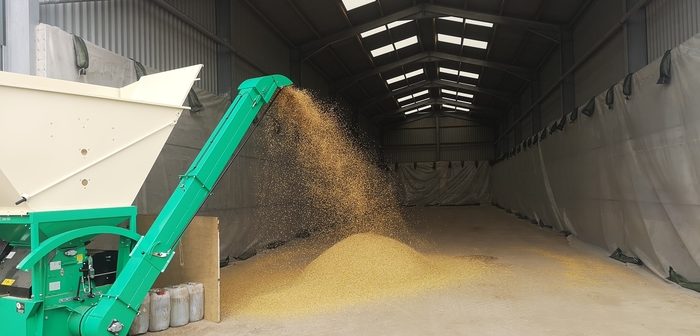Cereal growers have been reminded of the importance of self-reliance, following the recent closure of a Scottish grain merchant, which hundreds of farmers were said to be using for trading or storage.
When administrators were appointed at Alexander Inglis & Son last month, many growers found themselves unpaid for grain they’d supplied or at risk of losing grain being stored on their behalf.
As unsecured creditors with little prospect of payment, growers have been reminded of alternative options which remove third parties from the process and keep the storage and handling of grain completely in their own hands. This could be particularly important this year, when storage facilities are expected to be in short supply for farmers in the north of England and Scotland.
Feed preservation specialists, Kelvin Cave Ltd, have put forward a variety of options which cut out the middleman, and allow grain to be safely stored on farm without specialist facilities. And whilst they appreciate this may involve using or selling grain for animal feed, without a milling or malting premium, the costs involved are substantially lower, and in some cases, yields will be higher if harvested in the recommended way.
At the top of the list is the option of crimping, which involves rolling early harvested, moist grain and treating it with a preservative. This allows for extremely stable storage at moisture contents of 25-40%, without specialist storage or any grain drying needs.
Crimped grain is an extremely safe and effective feed for livestock and can also be traded from farm to farm. This opens up an option to arable farmers which they may not have considered before.

Michael Carpenter
As Michael Carpenter from Kelvin Cave Ltd explains: “Arable farmers may not be aware of how easy it is to trade crimped grain and how easy it is to store.
“It is harvested two to three weeks earlier than conventional dried grain, so it benefits from a dry matter yield and quality advantage thanks to greater avoidance of senescence and disease.
“The absence of any drying cost can also represent a significant financial saving, depending on the year.
“And the ease with which it can be stored, in something as simple as a makeshift clamp which could be made in a temporary form from large bales, makes it extremely cheap and viable.
“All that’s needed are anaerobic conditions which, with good practice, are not difficult to achieve,” he says. “Alternatively, it could be moved by trailer to a new destination and treated on the buyer’s farm.
“Either way, there are many contractors who keep the necessary equipment for crimping and there are also new platforms facilitating very cost-effective trading from farm to farm.
“However, it’s essential to ensure the grain is treated with a proven formulation of preservative salts which are essential to stable storage and subsequent animal performance.”
He also highlights the agronomic benefits which arable farmers who have converted find substantially add to the attraction of crimp.
“These range from the early harvest, which opens the way for earlier autumn cultivations, to better control of blackgrass. This has been proven in ADAS trials to be a benefit of harvesting grain earlier and crimping with the preservative, CrimpSafe 300,” he says.
Superb performance for dairy, beef and even sheep can also be achieved with crimp, which is safer for the rumen, more digestible and less likely to cause acidosis than conventional dry rolled grain.
“However, there are other options as well as crimping which may suit a farmer in different circumstances, although some grain preservatives, including propionic acid, are in short supply this year, so supplies need securing at the earliest opportunity,” he says.
Growers who are interested in crimping or other preservation solutions are advised to contact Kelvin Cave Ltd who can help with a range of options for alternative grain, pulse and forage storage and use.
“This whole incident highlights the risk involved in placing a valuable commodity in a third party’s care,” he concludes. “We believe that financial losses incurred through switching from the milling or malting market to animal feed are potentially offset by the yield, agronomic and livestock benefits of growing cereals to crimp.
“The reduced risk involved gives peace of mind, and for livestock farmers, using crimp can substantially cut the use of bought-in concentrate feeds.
“At a time when the farming industry is focussed on self-reliance, reducing food miles and cutting carbon emissions, cereals grown and treated at home or on a local farm have an important part to play.”
Key facts
- Cereal growers have been urged to consider crimping cereals instead of relying on third party storage.
- Crimped cereals can be stored on farm in a clamp or plastic tube, and traded farm to farm.
- Cereals for crimping are harvested two to three weeks earlier than dry grain.
- Correctly crimped and preserved cereals are more digestible than dry grain which can result in better animal performance.
- Crimping cereals has agronomic benefits including a less weather-dependent harvest, earlier autumn cultivations and better blackgrass control.




